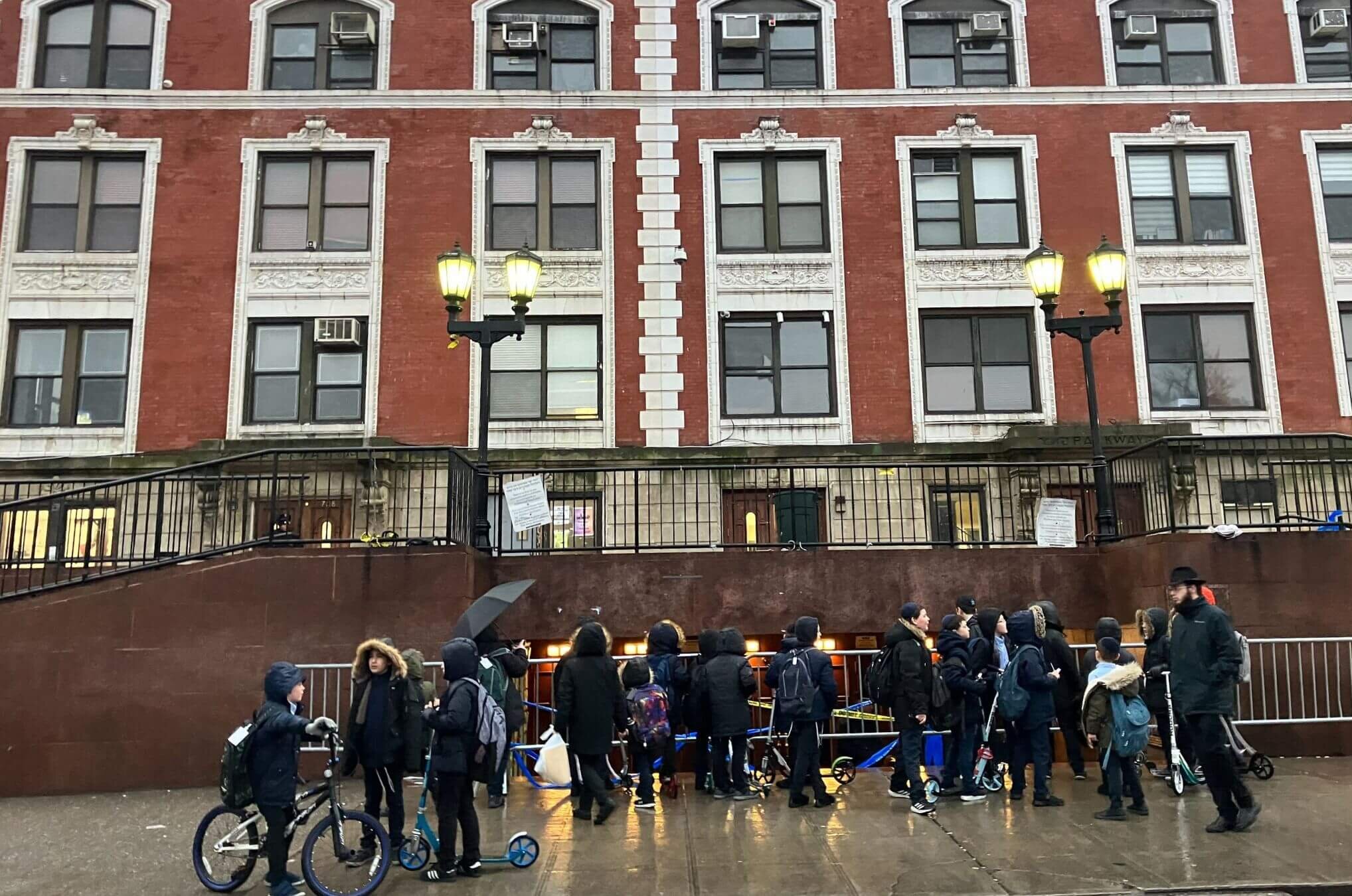So why were those yeshiva students digging a tunnel at Chabad headquarters?
The fracas reveals deep rifts in the Lubavitcher community between officials and those who see the Rebbe as the messiah

Children outside the synagogue at 784-788 Eastern Parkway in Brooklyn, New York, on Tuesday. Photo by Mira Fox
A near-riot and nine arrests at Chabad Lubavitch headquarters are bringing attention to deep rifts between Chabad officials and those who openly believe their late Rebbe is the messiah.
The fracas Monday at 770 Eastern Parkway in the Crown Heights section of Brooklyn began when a cement truck arrived to fill in a tunnel dug by a group of messianic yeshiva students who believe in the imminent return of the movement’s late leader, Rabbi Mendel Schneerson. The passageway was apparently used to dump debris from an unauthorized expansion of the synagogue onto an unused property next door.
Once they realized the tunnel was being filled in, the black-hatted young men tore down wooden panels, exposing the tunnel. The Associated Press reported Tuesday that nine people — between the ages of 19 and 22 — were arrested, with another three charged with disorderly conduct. Chabad spokesperson Rabbi Motti Seligson said that the building was closed pending a structural safety review.
Seligson described the vandals as “extremist students” who broke through walls from the synagogue at Chabad headquarters to create “unauthorized access” to adjacent properties.
Selvin Hernandez, the owner of the cement truck that pulled up to the site, said a dozen of the young men surrounded it, and took parts off it, including a clamp. His workers at Eagle Pumping Corp are scared, he said, and “don’t want to go over there no more.”
The group of messianists, known by the Yiddish term meshichisten, have congregated in the synagogue in the building’s basement for years; many are from Israel. But they are not permitted upstairs, where the organization’s official offices are located.
Theories on why they dug
Precisely why they began to dig the passageway is unclear. But one member of the community, Mendel G., who for fear of retribution agreed to speak only if his full last name not be used, said the tunnel diggers were trying to bring to fruition an expansion of the synagogue that Schneerson himself had endorsed. He noted that the Rebbe, as Schneerson is known, had placed its ceremonial cornerstone. Financial strain, regulatory issues and infighting following Schneerson’s 1994 death stalled the project.
But a few years ago, said Mendel G., some students took matters into their own hands and began excavating.
“The plan has been there for years. Everybody wants it to happen,” said Mendel G., 30, who received ordination from the Chabad yeshiva at 770, said of the expansion. “It just takes a few people with guts to show that it could get done.”
The students brought in a contractor to advise them on safety matters, added Mendel G, who was in the building when the ruckus began. He was unsure how many students were involved in the project, but said they started around four years ago.
Other reasons for the tunnel have been floated. Some say they dug it to preserve access in case they were banned from the building. Still others say the digging began to preserve access during the 2020 pandemic shutdown, when New York sought to limit indoor gatherings. But Mendel G. said that theory doesn’t hold up because the tunnel was never used or intended for people to travel back and forth, but as a way to jumpstart the expansion.
EXCLUSIVE: An early 3D rendering of what the Chabad "tunnel" was eventually intended to achieve — an adjoining space for prayer connected to the existing sanctuary through its south wall.
Provided by a source aware of the tunnel project—not involved in its construction. pic.twitter.com/McdhpGhUb1
— Louis Keene (@thislouis) January 10, 2024
Yaacov Behrman, who functions as a public relations liaison for Chabad, said on X that “rogue individuals were attempting to excavate an area for an illegal cellar adjacent to the synagogue” and that they had dug the passageway from that area to a neighboring vacant property in order to dispose of debris. (Seligson objected to calling the opening a tunnel, but it appears to be just that on video widely posted online.)
One anonymous but self-described “devoted” messianist said in a comment to a news story online that the group’s “actions in expanding 770 are not only justified but are a crucial step in preparing for the imminent arrival of Moshiach,” using a Yiddish term for Messiah. “The Rebbe, our dear leader and the Moshiach himself, initiated the groundbreaking for this expansion in 1988,” this devotee wrote, “laying down a clear path for us to follow. This was not merely a physical expansion; it was a divine directive, a preparation for the era of Moshiach.”
In breaking down the wall, this person wrote, the students were “actively participating in hastening the arrival of Moshiach.”
Leadership vacuum
Whatever the explanation, the brouhaha has brought the community’s divisions into the public eye, underscoring a “leadership vacuum” that has existed since the Rebbe’s death three decades ago, according to Samuel Heilman, a City of New York University professor emeritus and Chabad expert.
“You can’t run a movement this size with all of these different points of view without someone who says what’s correct and what’s not correct,” Heilman said in a phone interview from Israel, where he now lives, “particularly in Hasidic life where so much is put in the hands of the Rebbe. If you don’t have a living Rebbe, this is the kind of thing that happens.”
On the face of it, the organization’s influence has expanded worldwide since the Rebbe’s death. There are now 3,500 Chabad houses operating in hundreds of neighborhoods and college towns around the U.S. and in another 100 countries around the world.
But back in Brooklyn, Chabad’s establishment and the insurgents have clashed over messaging as well as control of the building. The messianists periodically blitz New York and other cities with posters proclaiming “Moshiach (the messiah) is coming!” featuring pictures of the Rebbe. While that message is officially frowned on by Chabad’s leadership, it is not without some support in the community.
The court battles
Meanwhile, court battles have raged for years over who has ownership rights to the main synagogue in the iconic building. Lubavitch officials “have attempted to gain proper control of the premises through the New York state court system; unfortunately, despite consistently prevailing in court, the process has dragged on for years,” Seligson said.
Chabad leadership’s legal antagonists are the managers of the synagogue, known as the Gabbaim. But both parties agree that the tunnel is a bad idea. Mendel G. said it was the Gabbaim who made arrangements for the tunnel to be filled.
Referring to the chaotic, debris-strewn premises shown on video, Heilman said, “Nothing could show the disarray and lack of leadership more than the way that room looked.”
He said he wasn’t so sure that the tunnel was dug to ensure access as to “get them space they could call their own. But it was without any permission, without any expertise, and it’s clearly undermined respect for Chabad.”
Conspiracy theories
News of the fracas also led to the eruption on social media of baseless and antisemitic conspiracy theories suggesting that the tunnels were being used for child sex trafficking and even child sacrifice. “Since the Jews enjoy killing babies in Gaza, it wouldn’t be bad to assume that they murdered babies in those satanic Synagogue tunnels,” tweeted one conspiracist.
Shloime Zionce, a Hasidic podcaster, noted on X that “the internet is now filled with wild conspiracy theories regarding the tunnels which were dug under 770 Eastern Parkway. It’s going to take a long time to disprove, dispel, and discredit these crazy rumors. The time has time [sic] for community leaders to take action and shut down the troublemakers once and for all.”
Worldwide replicas of 770
The three-gabled building at 770 Eastern Parkway is architecturally unremarkable in Brooklyn, where streetscapes with brick-and-stone Gothic Revival structures from the early 20th century abound. But in the Chabad world, it is revered. Three dozen replicas have been built around the world, including in India, Brazil, Italy, Australia and Texas.
And what about the messianists’ apparent disregard for safety in undertaking their impromptu renovations in a city where building collapses and gas pipe explosions are not unusual? “These are people who are not in a great relationship with reality,” Heilman said. “Many of them are young and uneducated. At the same time, they see themselves, these kids, these meshichisten, as the genuine Chabad.” He added that some of them “not only believe the Rebbe is the messiah, but they think he’s here already even though they can’t see him.”
He also noted the “irony of it happening at the same time that here in Israel, we’re fighting an enemy in tunnels,” an irony that was echoed by many commenting on social media.
But he dismissed one other theory — that the bochurim undertook the digging only recently because they believe war in the Middle East presages the Rebbe’s imminent return.
“There’s always war in the Middle East,” he said.
























